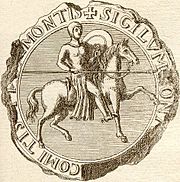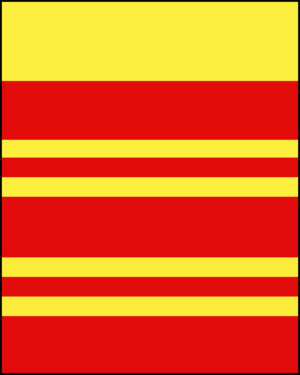Conan IV, Duke of Brittany facts for kids
Quick facts for kids Conan IV |
|
|---|---|
 |
|
| Duke of Brittany | |
| Reign | 1156–1166 |
| Predecessor | Odo II & Bertha |
| Successor | Constance |
| Earl of Richmond | |
| Tenure | 1146–1166 |
| Predecessor | Alan |
| Successor | Constance |
| Born | c. 1138 |
| Died | 20 February 1171 |
| Burial | Bégard Monastery |
| Spouse | Margaret of Huntingdon |
| Issue | Constance, Duchess of Brittany William |
| House | Penthièvre |
| Father | Alan, 1st Earl of Richmond |
| Mother | Bertha, Duchess of Brittany |
Conan IV (born around 1138 – died February 20, 1171), also known as the Young, was an important ruler in the Middle Ages. He was the Duke of Brittany from 1156 to 1166. Brittany is a region in France with its own unique history and culture.
Conan was the son of Bertha, Duchess of Brittany, and her first husband, Alan, 1st Earl of Richmond. This meant he was set to inherit two important titles. He was his father's heir as Earl of Richmond and his mother's heir as Duke of Brittany. Conan and his daughter Constance were the only rulers from their family, the House of Penthièvre, to govern Brittany.
Contents
Becoming Duke: Conan's Rise to Power
When Conan's mother, Duchess Bertha, passed away in early 1156, Conan IV expected to become the new Duke of Brittany. However, his stepfather, Odo II, Viscount of Porhoët, refused to give up control. Odo might have even made a deal with Conan's uncle, Hoel, Count of Nantes, to divide Brittany between them.
Luckily for Conan, Hoel was facing his own problems. He was dealing with a rebellion in Nantes, which was supported by Geoffrey VI, Count of Anjou. Because of this, Hoel couldn't send any help to Odo. Within a year, Conan IV was able to capture and imprison Odo. This allowed Conan to finally claim his rightful place as Duke.
Conan also inherited the title of Earl of Richmond from his father. This meant he had to answer to both the King of England and the King of France.
England's Influence: The Plantagenet Kings
Henry II of England, who was also the Count of Anjou, wanted to control the Duchy of Brittany. Brittany was right next to his lands and had always been quite independent from the rest of France. It even had its own language and culture.
At this time, the Dukes of Brittany didn't have much power over the whole region. Most of the duchy was controlled by local lords. In 1148, Duke Conan III died, and a civil war broke out in Brittany. Henry II claimed that Brittany should be loyal to him, just as it had been to his grandfather, Henry I. He saw controlling Brittany as a way to protect his other French lands and perhaps even pass it on to one of his sons.
Initially, Henry tried to rule Brittany indirectly, using other people to do his bidding. He supported Conan IV's claim to most of the duchy. This was partly because Conan had strong ties to England and could be easily influenced. Conan's uncle, Hoel, continued to control the county of Nantes in the east. But in 1156, Henry's brother, Geoffrey, removed Hoel from power, possibly with Henry's help.
When Geoffrey of Anjou died in 1158, Conan tried to take back Nantes. However, Henry II stopped him and took Nantes for himself. The King of France, Louis, did nothing to interfere as Henry steadily gained more power in Brittany. Conan's control of Nantes had briefly brought Brittany back together.
Henry II reacted by taking back the Earldom of Richmond, which was Conan's family inheritance. He also demanded that Nantes be returned to him. Conan and Henry eventually made peace. In 1160, Conan married Henry's cousin, Margaret. Margaret was the sister of the Scottish king, William the Lion. Conan and Margaret had at least one daughter, Constance. It seems they also had a son named William, who was still alive around the year 1200.
Challenges and Giving Up Power
Conan faced several rebellions from his own nobles. It's possible that England secretly supported these revolts. To stop the unrest, Conan asked Henry II for help. In return, Henry demanded that Conan's daughter, Constance, be promised in marriage to Henry's younger son, Geoffrey.
While local Breton nobles were rebelling against Conan IV, Henry II began to change his approach. He started to take more direct control over Brittany. In 1164, Henry took lands along the border between Brittany and Normandy. Then, in 1166, he invaded Brittany to punish the local lords.
Henry then forced Conan to step down as Duke. Conan had to give Brittany to his daughter Constance. He also had to agree to Constance marrying Henry's son Geoffrey. This was very unusual for the time, as Conan might have had sons who could have rightfully inherited the duchy.
Historical records show that Conan IV died in 1171, some time after he gave up his power.
Henry II claimed to be the "Overlord" of Brittany, meaning he had authority over it. His son, Richard the Lionheart, would also make this claim. However, Henry never claimed to be the Duke of Brittany himself. After Conan IV stepped down, Henry II became the guardian of Brittany for Conan's daughter Constance. He held this role until his fourth legitimate son, Geoffrey Plantagenet, could marry her.
Conan in Stories
Conan is often remembered in Breton history as a weak ruler. People thought he couldn't protect his duchy from the powerful English king. However, a historian named Eric Borgnis-Desbordes has recently suggested that this view might not be entirely fair.
Conan IV is mentioned in a few works of literature:
- The play Jean sans Terre ou la mort d'Arthur (1791) by Jean-François Ducis.
- The novels Time and Chance (2002), Prince of Darkness (2005), and Devil's Brood (2008) by Sharon Kay Penman.
- The second book of the trilogy Le Château des Poulfenc (2009) by Brigitte Coppin.
See also
- List of rulers of Brittany


